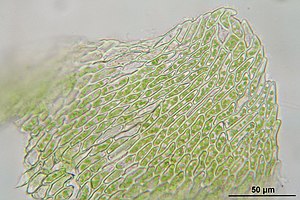Paraphyllium
Paraphyllium ( Greek para “near”, Gr. Phyllon “leaf”, mostly used in the plural paraphyllia or paraphyllia ) describes a small filament, scale or leaf-like structure on the stems of some leaf-bearing mosses . Most of the time, the paraphyllia are slit or awl-shaped small structures. They enlarge the photosynthetically active area. Other functions are speculative.

Thuidium delicatulum - Paraphyllia of the tender thuja moss

Microscope image of Pseudoparaphyllium (cross section of the trunk of Hypnum procerrimum )
Pseudoparaphyllia are corresponding leaf-like structures between the leaves of Trichocoleales . You can water through capillary action spongelike bind (z. B. with bunk Moss , tamarisk Thujamoos , Tender Thujamoos , Mnium ).
Single receipts
- ^ Bill Malcolm, Nancy Malcolm: Mosses and other Bryophytes, an illustrated glossary. Moss Ontology, 2nd Edition, 2006
- ↑ Arthur Jonathan Shaw, Bernard Goffinet: Bryophyte Biology. Cambridge University Press, 2000, ISBN 0-521-66794-1 , p. 76
- ↑ Water relations: plant strategies. (PDF; 1.3 MB) Chapter 7–3, p. 23 (clearly illustrated)
- ↑ DR Zehr: phenology of selected bryophytes in southern Illinois. Bryologist, Vol. 82, 1979, pp. 29-36.